engine MAZDA MODEL 3 HATCHBACK 2010 (in English) Manual Online
[x] Cancel search | Manufacturer: MAZDA, Model Year: 2010, Model line: MODEL 3 HATCHBACK, Model: MAZDA MODEL 3 HATCHBACK 2010Pages: 488, PDF Size: 6.52 MB
Page 337 of 488
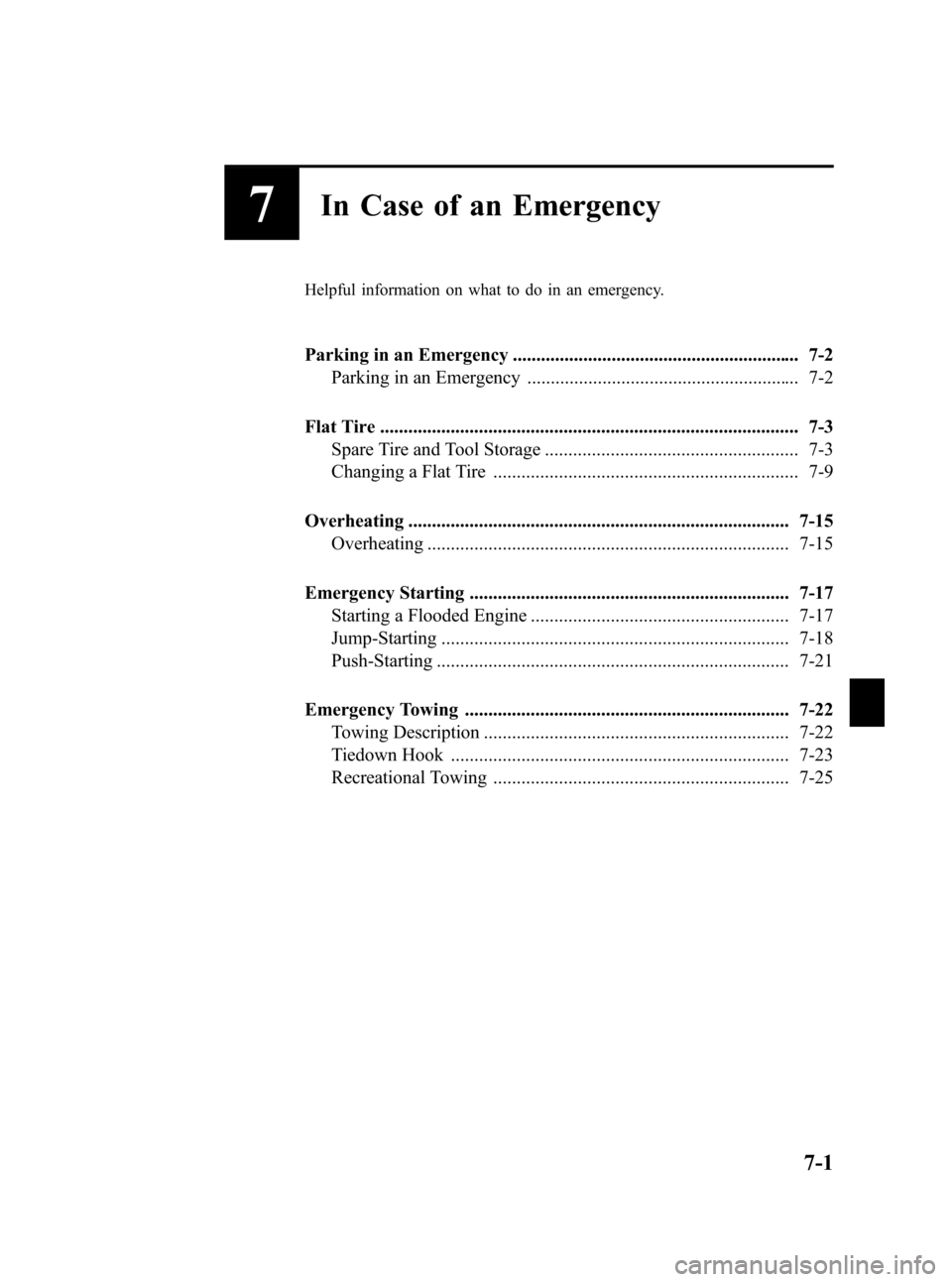
Black plate (339,1)
7In Case of an Emergency
Helpful information on what to do in an emergency.
Parking in an Emergency ............................................................. 7-2
Parking in an Emergency .......................................................... 7-2
Flat Tire ......................................................................................... 7-3
Spare Tire and Tool Storage ...................................................... 7-3
Changing a Flat Tire ................................................................. 7-9
Overheating ................................................................................. 7-15
Overheating ............................................................................. 7-15
Emergency Starting .................................................................... 7-17
Starting a Flooded Engine ....................................................... 7-17
Jump-Starting .......................................................................... 7-18
Push-Starting ........................................................................... 7-21
Emergency Towing ..................................................................... 7-22
Towing Description ................................................................. 7-22
Tiedown Hook ........................................................................ 7-23
Recreational Towing ............................................................... 7-25
7-1
Mazda3_8AD6-EC-09A_Edition1 Page339
Tuesday, December 2 2008 2:28 PM
Form No.8AD6-EC-09A
Page 345 of 488
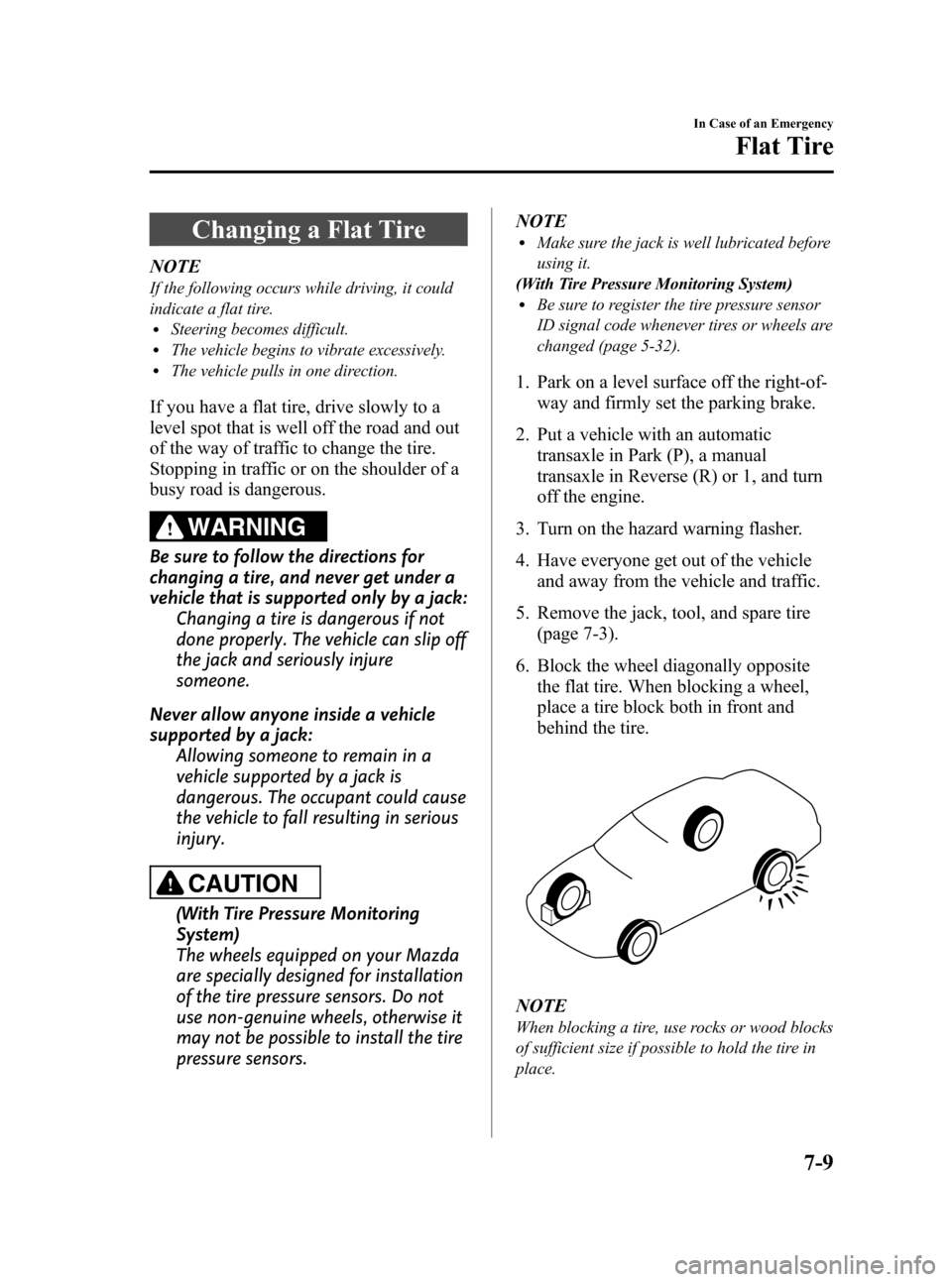
Black plate (347,1)
Changing a Flat Tire
NOTE
If the following occurs while driving, it could
indicate a flat tire.
lSteering becomes difficult.lThe vehicle begins to vibrate excessively.lThe vehicle pulls in one direction.
If you have a flat tire, drive slowly to a
level spot that is well off the road and out
of the way of traffic to change the tire.
Stopping in traffic or on the shoulder of a
busy road is dangerous.
WARNING
Be sure to follow the directions for
changing a tire, and never get under a
vehicle that is supported only by a jack:
Changing a tire is dangerous if not
done properly. The vehicle can slip off
the jack and seriously injure
someone.
Never allow anyone inside a vehicle
supported by a jack:
Allowing someone to remain in a
vehicle supported by a jack is
dangerous. The occupant could cause
the vehicle to fall resulting in serious
injury.
CAUTION
(With Tire Pressure Monitoring
System)
The wheels equipped on your Mazda
are specially designed for installation
of the tire pressure sensors. Do not
use non-genuine wheels, otherwise it
may not be possible to install the tire
pressure sensors.NOTE
lMake sure the jack is well lubricated before
using it.
(With Tire Pressure Monitoring System)
lBe sure to register the tire pressure sensor
ID signal code whenever tires or wheels are
changed (page 5-32).
1. Park on a level surface off the right-of-
way and firmly set the parking brake.
2. Put a vehicle with an automatic
transaxle in Park (P), a manual
transaxle in Reverse (R) or 1, and turn
off the engine.
3. Turn on the hazard warning flasher.
4. Have everyone get out of the vehicle
and away from the vehicle and traffic.
5. Remove the jack, tool, and spare tire
(page 7-3).
6. Block the wheel diagonally opposite
the flat tire. When blocking a wheel,
place a tire block both in front and
behind the tire.
NOTE
When blocking a tire, use rocks or wood blocks
of sufficient size if possible to hold the tire in
place.
In Case of an Emergency
Flat Tire
7-9
Mazda3_8AD6-EC-09A_Edition1 Page347
Tuesday, December 2 2008 2:28 PM
Form No.8AD6-EC-09A
Page 351 of 488
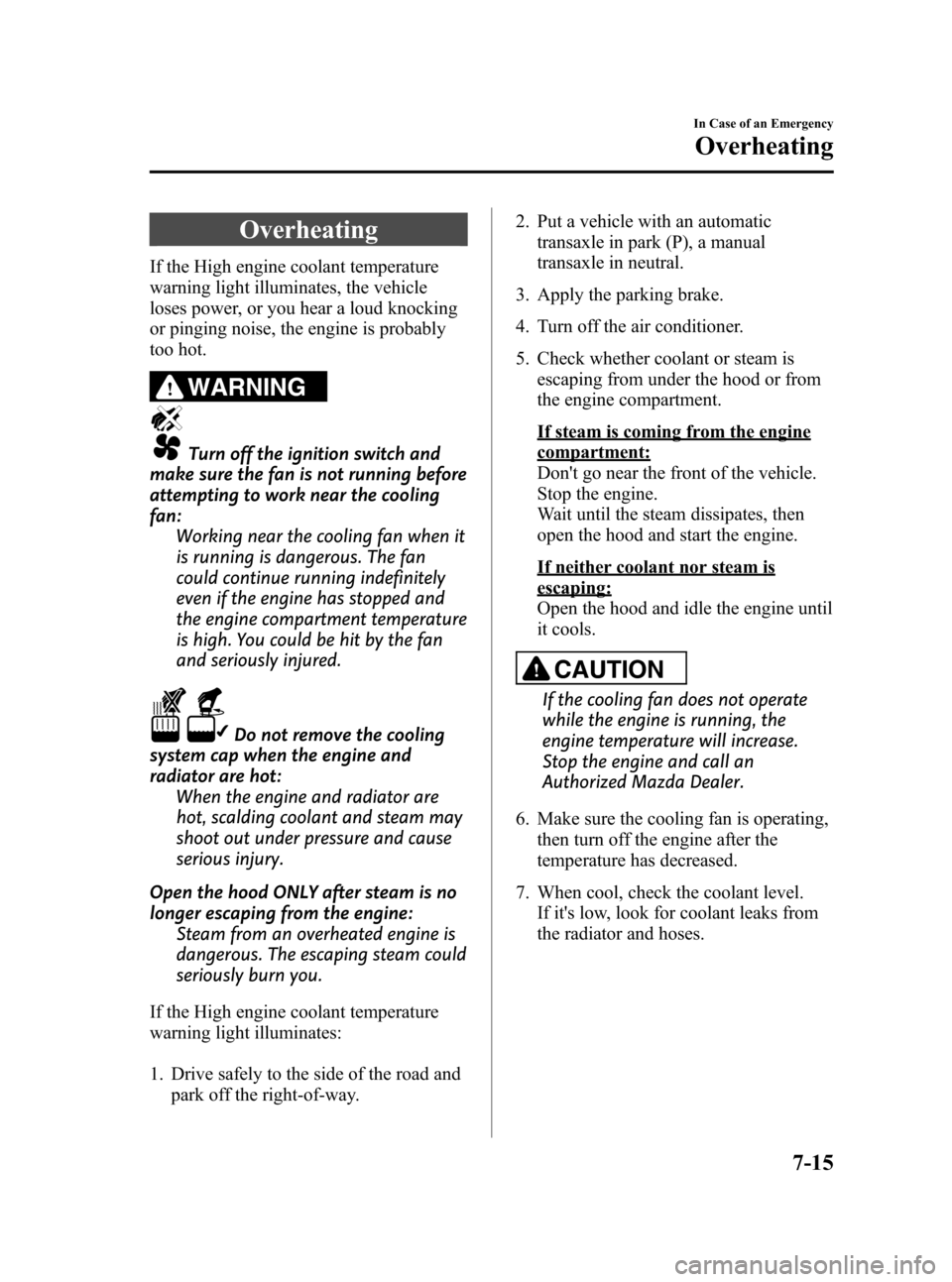
Black plate (353,1)
Overheating
If the High engine coolant temperature
warning light illuminates, the vehicle
loses power, or you hear a loud knocking
or pinging noise, the engine is probably
too hot.
WARNING
Turn off the ignition switch and
make sure the fan is not running before
attempting to work near the cooling
fan:
Working near the cooling fan when it
is running is dangerous. The fan
could continue running indefinitely
even if the engine has stopped and
the engine compartment temperature
is high. You could be hit by the fan
and seriously injured.
Do not remove the cooling
system cap when the engine and
radiator are hot:
When the engine and radiator are
hot, scalding coolant and steam may
shoot out under pressure and cause
serious injury.
Open the hood ONLY after steam is no
longer escaping from the engine:
Steam from an overheated engine is
dangerous. The escaping steam could
seriously burn you.
If the High engine coolant temperature
warning light illuminates:
1. Drive safely to the side of the road and
park off the right-of-way.2. Put a vehicle with an automatic
transaxle in park (P), a manual
transaxle in neutral.
3. Apply the parking brake.
4. Turn off the air conditioner.
5. Check whether coolant or steam is
escaping from under the hood or from
the engine compartment.
If steam is coming from the engine
compartment:
Don't go near the front of the vehicle.
Stop the engine.
Wait until the steam dissipates, then
open the hood and start the engine.
If neither coolant nor steam is
escaping:
Open the hood and idle the engine until
it cools.
CAUTION
If the cooling fan does not operate
while the engine is running, the
engine temperature will increase.
Stop the engine and call an
Authorized Mazda Dealer.
6. Make sure the cooling fan is operating,
then turn off the engine after the
temperature has decreased.
7. When cool, check the coolant level.
If it's low, look for coolant leaks from
the radiator and hoses.
In Case of an Emergency
Overheating
7-15
Mazda3_8AD6-EC-09A_Edition1 Page353
Tuesday, December 2 2008 2:28 PM
Form No.8AD6-EC-09A
Page 352 of 488
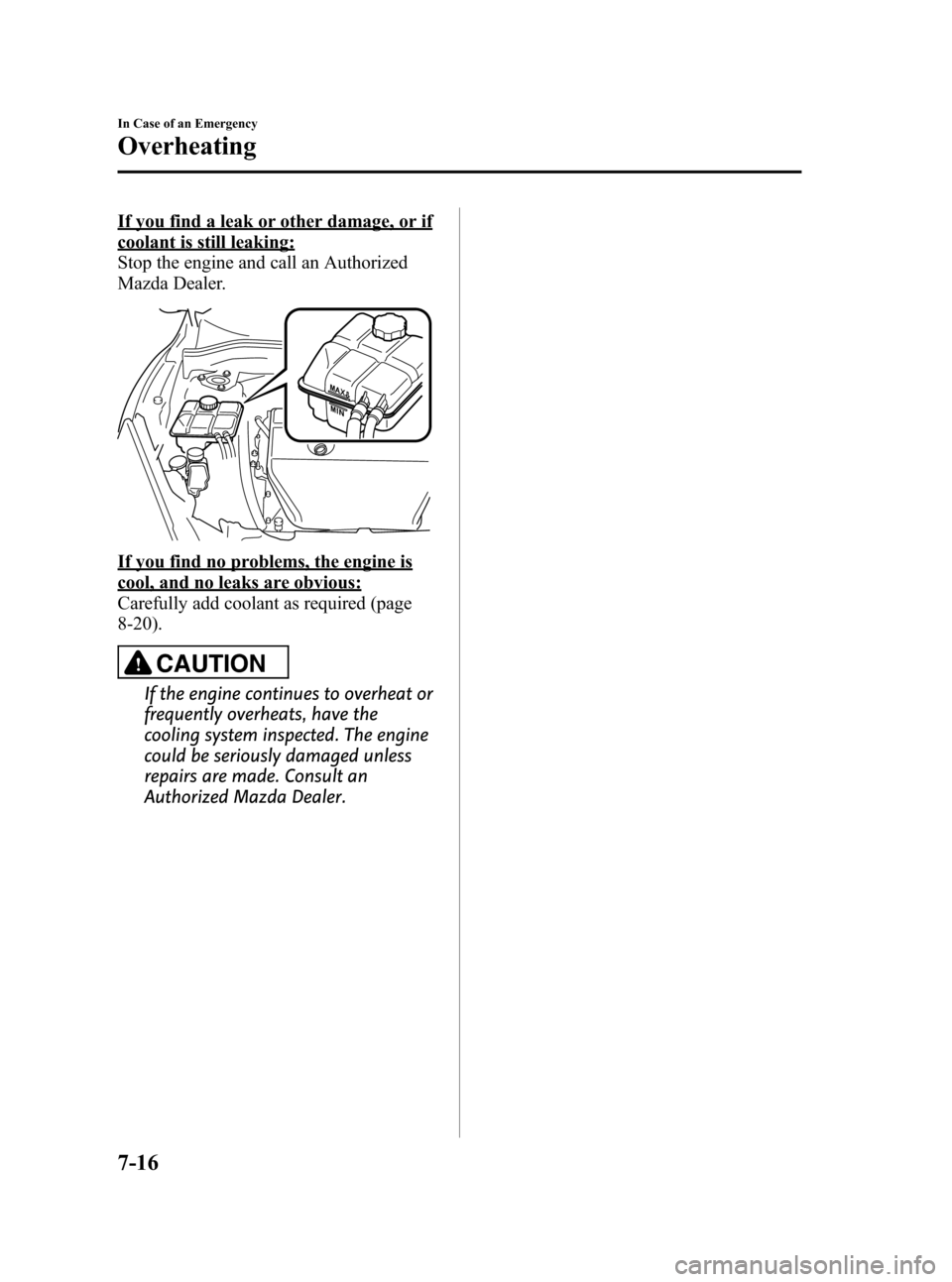
Black plate (354,1)
If you find a leak or other damage, or if
coolant is still leaking:
Stop the engine and call an Authorized
Mazda Dealer.
If you find no problems, the engine is
cool, and no leaks are obvious:
Carefully add coolant as required (page
8-20).
CAUTION
If the engine continues to overheat or
frequently overheats, have the
cooling system inspected. The engine
could be seriously damaged unless
repairs are made. Consult an
Authorized Mazda Dealer.
7-16
In Case of an Emergency
Overheating
Mazda3_8AD6-EC-09A_Edition1 Page354
Tuesday, December 2 2008 2:28 PM
Form No.8AD6-EC-09A
Page 353 of 488

Black plate (355,1)
Starting a Flooded Engine
If the engine fails to start, it may be
flooded (excessive fuel in the engine).
Follow this procedure:
(Without Advanced Keyless Entry &
Push Button Start System)
1. If the engine does not start within five
seconds on the first try, turn the key to
the LOCK position, wait ten seconds
and try again.
2. Depress the accelerator all the way and
hold it there.
3. Turn the ignition switch to the START
position and hold it there―for up to
ten seconds. If the engine starts, release
the key and accelerator immediately
because the engine will suddenly rev
up.
4. If the engine fails to start, crank it
without depressing the accelerator―for
up to ten seconds.
(With Advanced Keyless Entry & Push
Button Start System)
1. If the engine does not start within five
seconds on the first try, wait ten
seconds and try again.
2. Depress the accelerator all the way and
hold it there.
3. Depress the clutch pedal (MT) or the
brake pedal (AT) then press the push
button start. If the engine starts, release
the key and accelerator immediately
because the engine will suddenly rev
up.
4. If the engine fails to start, crank it
without depressing the accelerator.If the engine still does not start using the
above procedure, have your vehicle
inspected by an Authorized Mazda
Dealer.
In Case of an Emergency
Emergency Starting
7-17
Mazda3_8AD6-EC-09A_Edition1 Page355
Tuesday, December 2 2008 2:28 PM
Form No.8AD6-EC-09A
Page 355 of 488
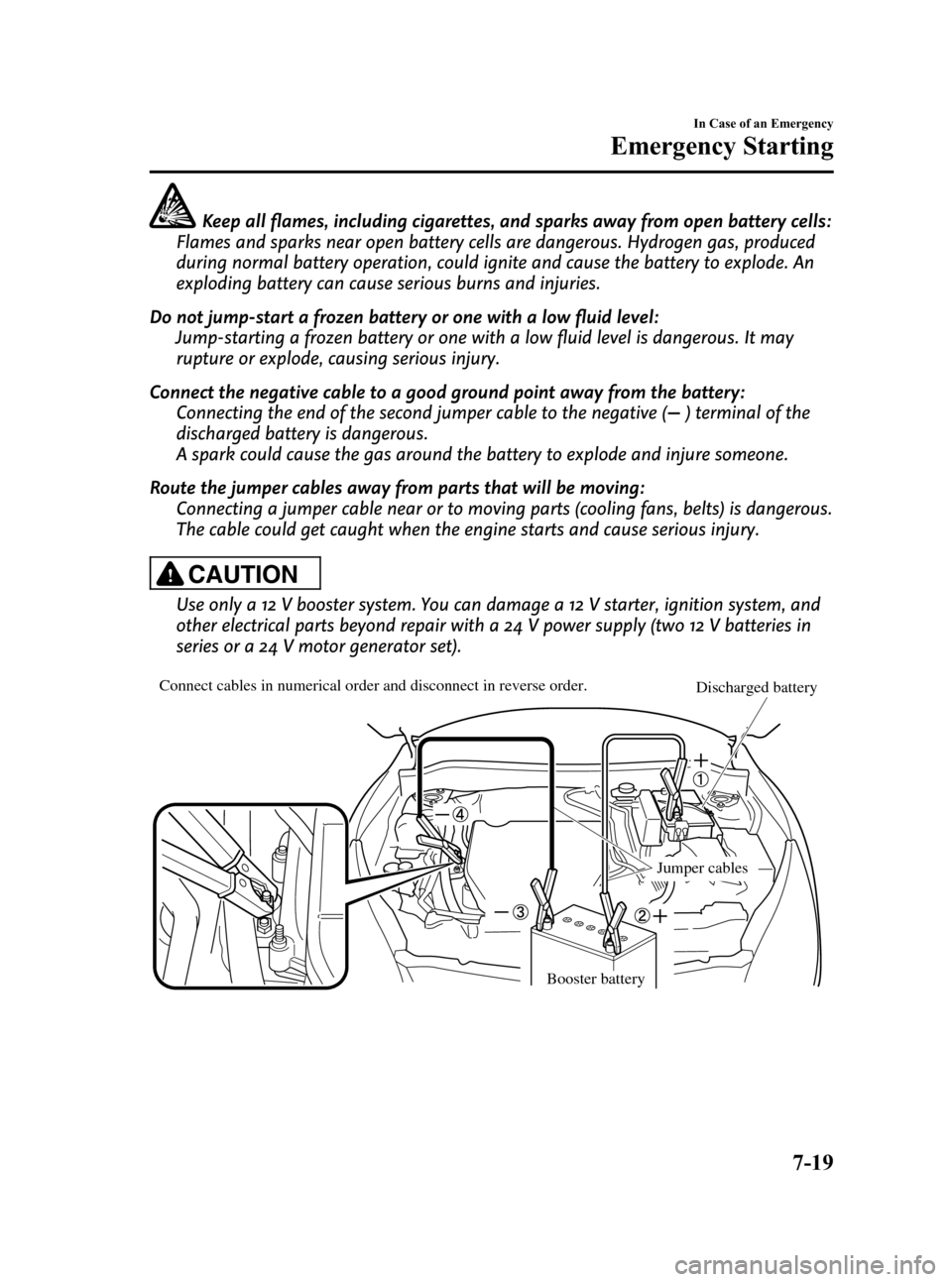
Black plate (357,1)
Keep all flames, including cigarettes, and sparks away from open battery cells:
Flames and sparks near open battery cells are dangerous. Hydrogen gas, produced
during normal battery operation, could ignite and cause the battery to explode. An
exploding battery can cause serious burns and injuries.
Do not jump-start a frozen battery or one with a low fluid level:
Jump-starting a frozen battery or one with a low fluid level is dangerous. It may
rupture or explode, causing serious injury.
Connect the negative cable to a good ground point away from the battery:
Connecting the end of the second jumper cable to the negative (
) terminal of the
discharged battery is dangerous.
A spark could cause the gas around the battery to explode and injure someone.
Route the jumper cables away from parts that will be moving:
Connecting a jumper cable near or to moving parts (cooling fans, belts) is dangerous.
The cable could get caught when the engine starts and cause serious injury.
CAUTION
Use only a 12 V booster system. You can damage a 12 V starter, ignition system, and
other electrical parts beyond repair with a 24 V power supply (two 12 V batteries in
series or a 24 V motor generator set).
Connect cables in numerical order and disconnect in reverse order.
Booster battery
Discharged battery
Jumper cables
In Case of an Emergency
Emergency Starting
7-19
Mazda3_8AD6-EC-09A_Edition1 Page357
Tuesday, December 2 2008 2:28 PM
Form No.8AD6-EC-09A
Page 356 of 488
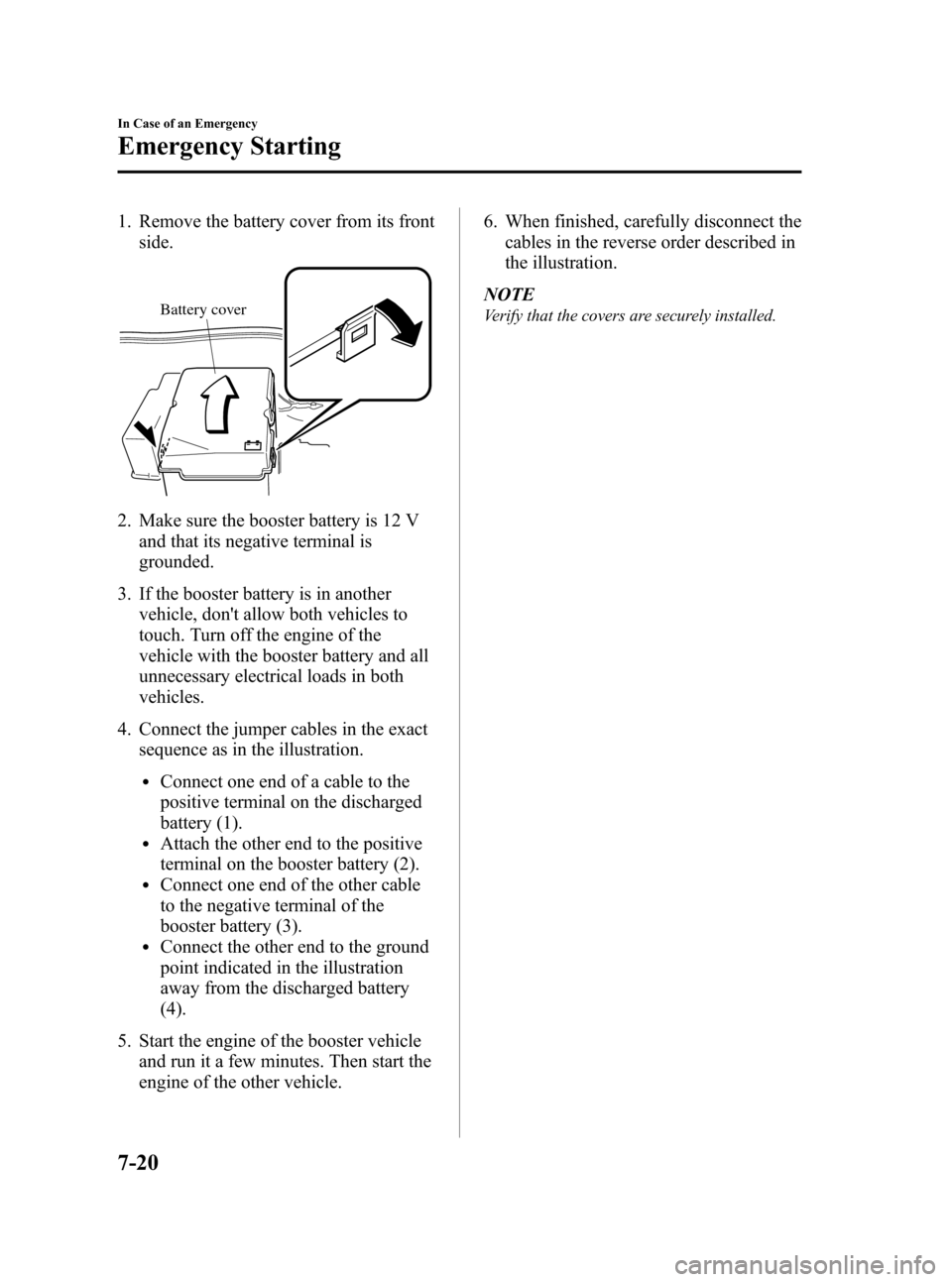
Black plate (358,1)
1. Remove the battery cover from its front
side.
Battery cover
2. Make sure the booster battery is 12 V
and that its negative terminal is
grounded.
3. If the booster battery is in another
vehicle, don't allow both vehicles to
touch. Turn off the engine of the
vehicle with the booster battery and all
unnecessary electrical loads in both
vehicles.
4. Connect the jumper cables in the exact
sequence as in the illustration.
lConnect one end of a cable to the
positive terminal on the discharged
battery (1).
lAttach the other end to the positive
terminal on the booster battery (2).
lConnect one end of the other cable
to the negative terminal of the
booster battery (3).
lConnect the other end to the ground
point indicated in the illustration
away from the discharged battery
(4).
5. Start the engine of the booster vehicle
and run it a few minutes. Then start the
engine of the other vehicle.6. When finished, carefully disconnect the
cables in the reverse order described in
the illustration.
NOTE
Verify that the covers are securely installed.
7-20
In Case of an Emergency
Emergency Starting
Mazda3_8AD6-EC-09A_Edition1 Page358
Tuesday, December 2 2008 2:28 PM
Form No.8AD6-EC-09A
Page 357 of 488
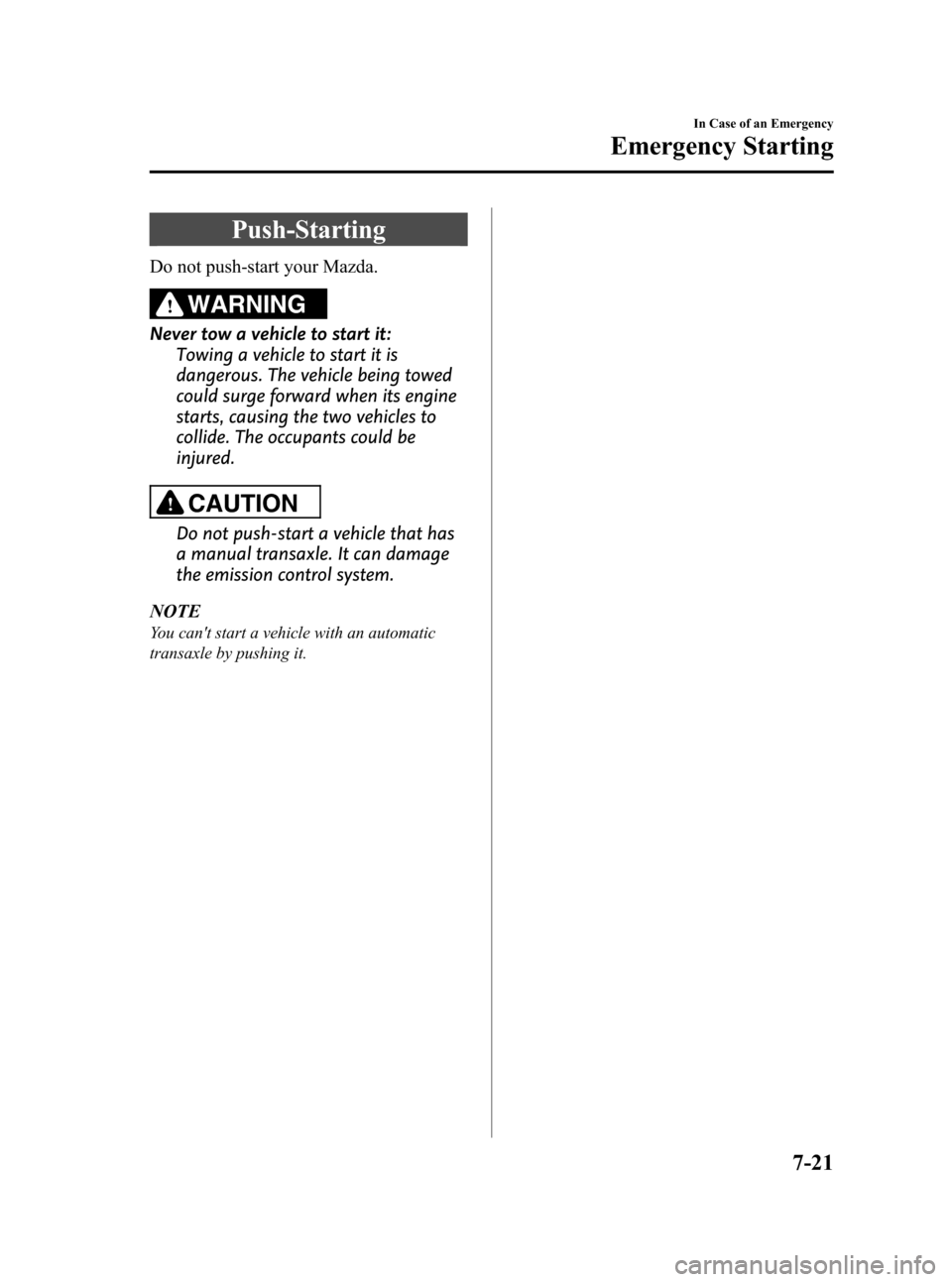
Black plate (359,1)
Push-Starting
Do not push-start your Mazda.
WARNING
Never tow a vehicle to start it:
Towing a vehicle to start it is
dangerous. The vehicle being towed
could surge forward when its engine
starts, causing the two vehicles to
collide. The occupants could be
injured.
CAUTION
Do not push-start a vehicle that has
a manual transaxle. It can damage
the emission control system.
NOTE
You can't start a vehicle with an automatic
transaxle by pushing it.
In Case of an Emergency
Emergency Starting
7-21
Mazda3_8AD6-EC-09A_Edition1 Page359
Tuesday, December 2 2008 2:28 PM
Form No.8AD6-EC-09A
Page 363 of 488
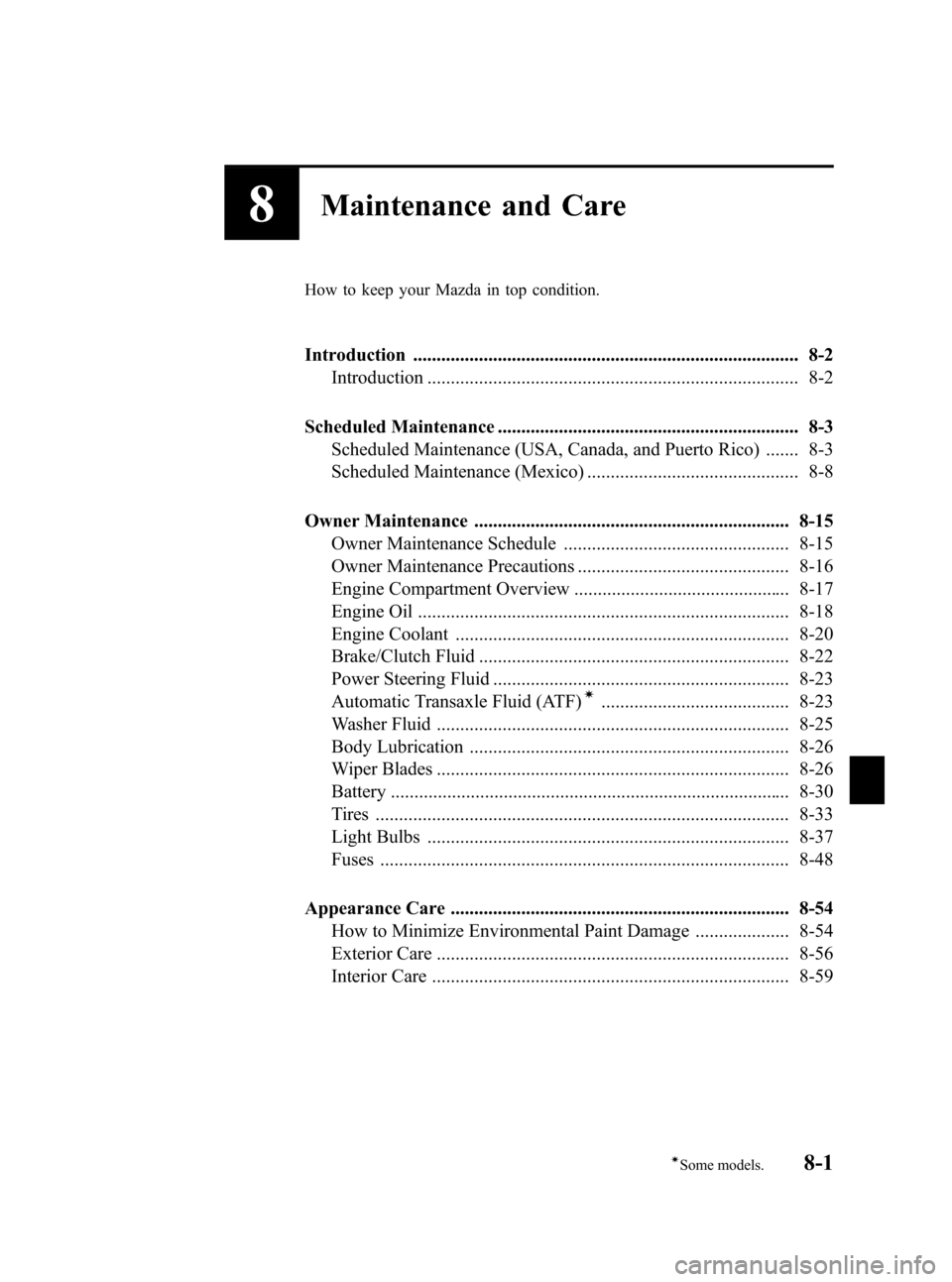
Black plate (365,1)
8Maintenance and Care
How to keep your Mazda in top condition.
Introduction .................................................................................. 8-2
Introduction ............................................................................... 8-2
Scheduled Maintenance ................................................................ 8-3
Scheduled Maintenance (USA, Canada, and Puerto Rico) ....... 8-3
Scheduled Maintenance (Mexico) ............................................. 8-8
Owner Maintenance ................................................................... 8-15
Owner Maintenance Schedule ................................................ 8-15
Owner Maintenance Precautions ............................................. 8-16
Engine Compartment Overview .............................................. 8-17
Engine Oil ............................................................................... 8-18
Engine Coolant ....................................................................... 8-20
Brake/Clutch Fluid .................................................................. 8-22
Power Steering Fluid ............................................................... 8-23
Automatic Transaxle Fluid (ATF)
í........................................ 8-23
Washer Fluid ........................................................................... 8-25
Body Lubrication .................................................................... 8-26
Wiper Blades ........................................................................... 8-26
Battery ..................................................................................... 8-30
Tires ........................................................................................ 8-33
Light Bulbs ............................................................................. 8-37
Fuses ....................................................................................... 8-48
Appearance Care ........................................................................ 8-54
How to Minimize Environmental Paint Damage .................... 8-54
Exterior Care ........................................................................... 8-56
Interior Care ............................................................................ 8-59
8-1íSome models.
Mazda3_8AD6-EC-09A_Edition1 Page365
Tuesday, December 2 2008 2:28 PM
Form No.8AD6-EC-09A
Page 366 of 488
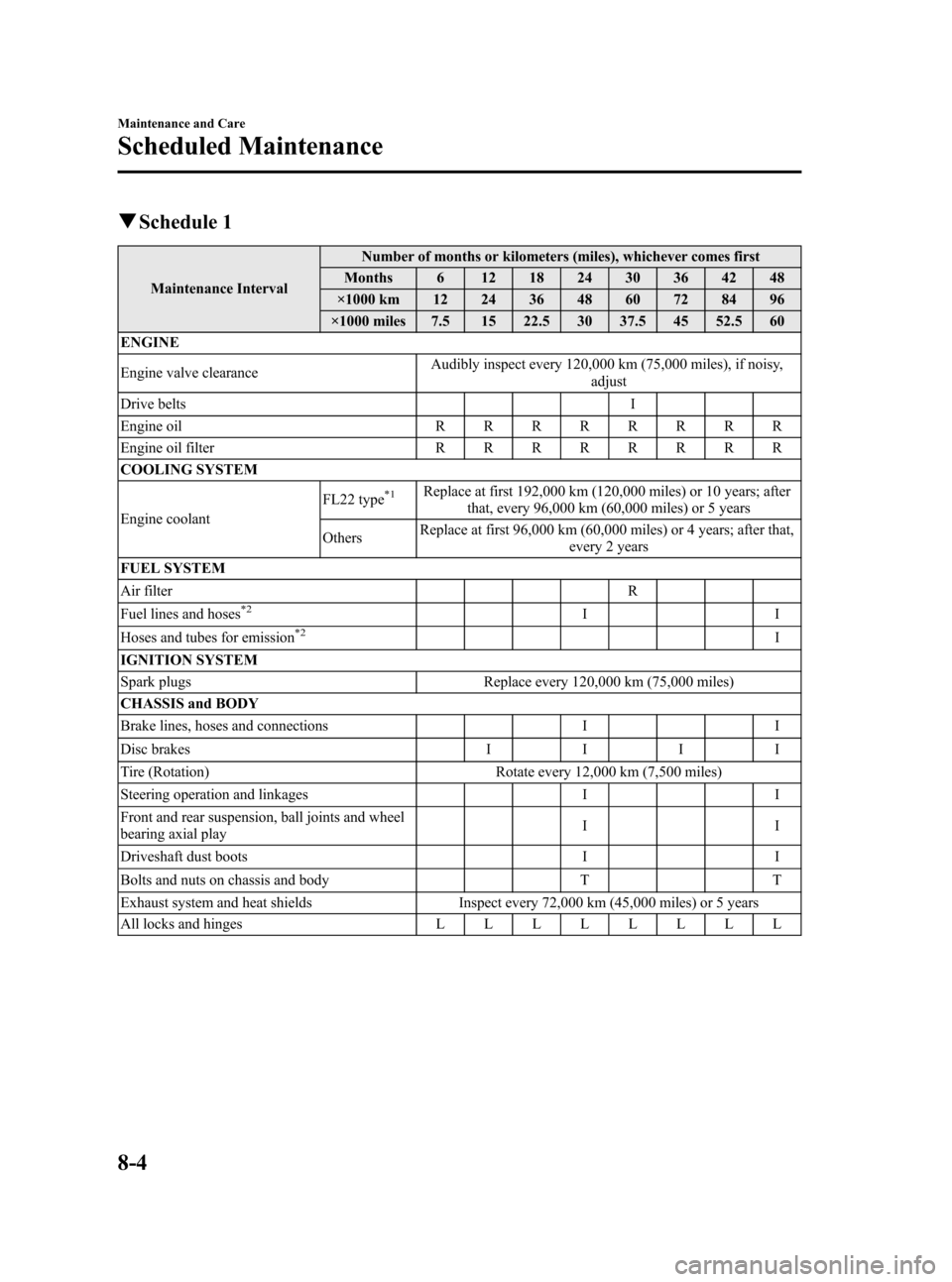
Black plate (368,1)
qSchedule 1
Maintenance IntervalNumber of months or kilometers (miles), whichever comes first
Months 6 12 18 24 30 36 42 48
×1000 km 12 24 36 48 60 72 84 96
×1000 miles 7.5 15 22.5 30 37.5 45 52.5 60
ENGINE
Engine valve clearanceAudibly inspect every 120,000 km (75,000 miles), if noisy,
adjust
Drive belts I
Engine oilRRRRRRRR
Engine oil filterRRRRRRRR
COOLING SYSTEM
Engine coolantFL22 type
*1Replace at first 192,000 km (120,000 miles) or 10 years; after
that, every 96,000 km (60,000 miles) or 5 years
OthersReplace at first 96,000 km (60,000 miles) or 4 years; after that,
every 2 years
FUEL SYSTEM
Air filter R
Fuel lines and hoses
*2II
Hoses and tubes for emission*2I
IGNITION SYSTEM
Spark plugs Replace every 120,000 km (75,000 miles)
CHASSIS and BODY
Brake lines, hoses and connections I I
Disc brakesIIII
Tire (Rotation) Rotate every 12,000 km (7,500 miles)
Steering operation and linkages I I
Front and rear suspension, ball joints and wheel
bearing axial playII
Driveshaft dust boots I I
Bolts and nuts on chassis and body T T
Exhaust system and heat shields Inspect every 72,000 km (45,000 miles) or 5 years
All locks and hingesLLLLLLLL
8-4
Maintenance and Care
Scheduled Maintenance
Mazda3_8AD6-EC-09A_Edition1 Page368
Tuesday, December 2 2008 2:28 PM
Form No.8AD6-EC-09A